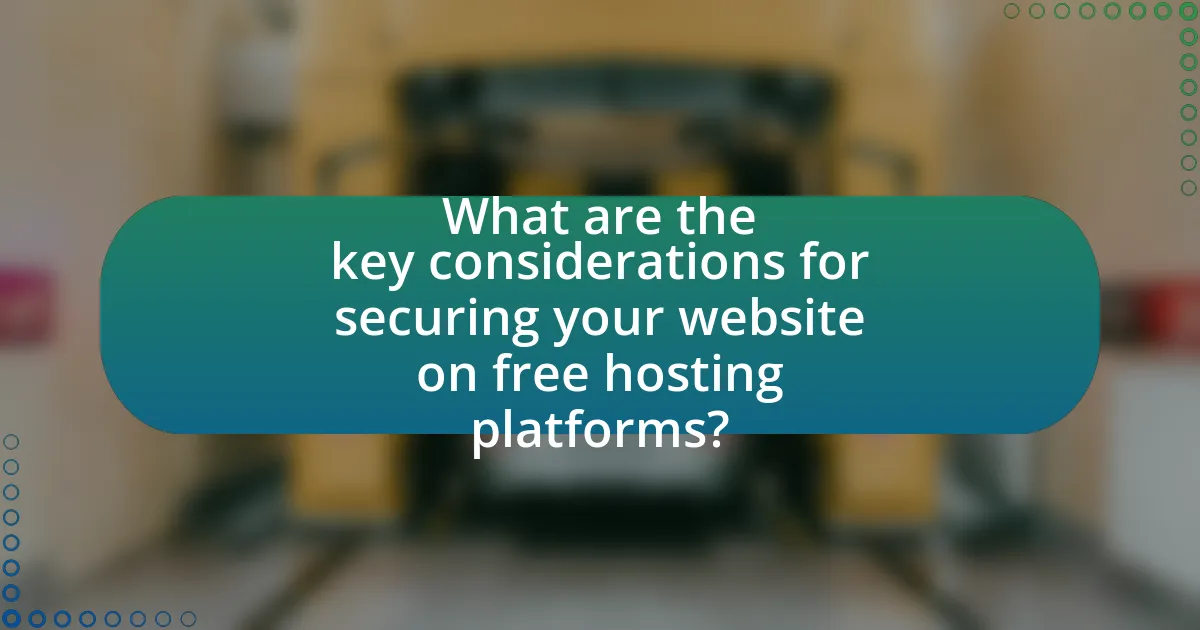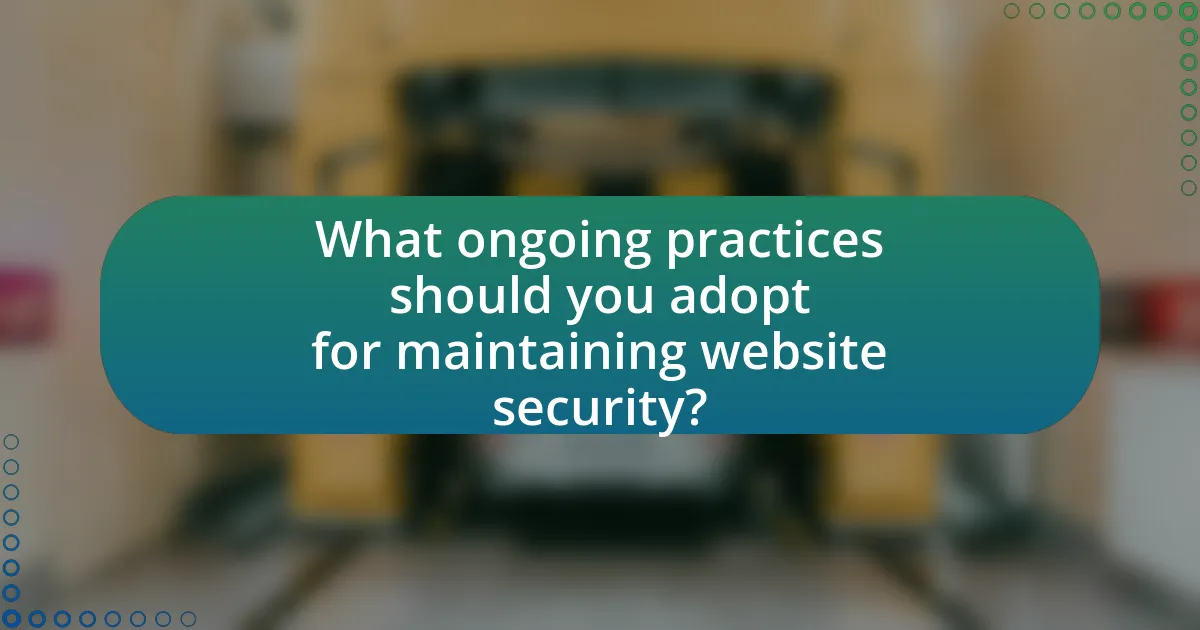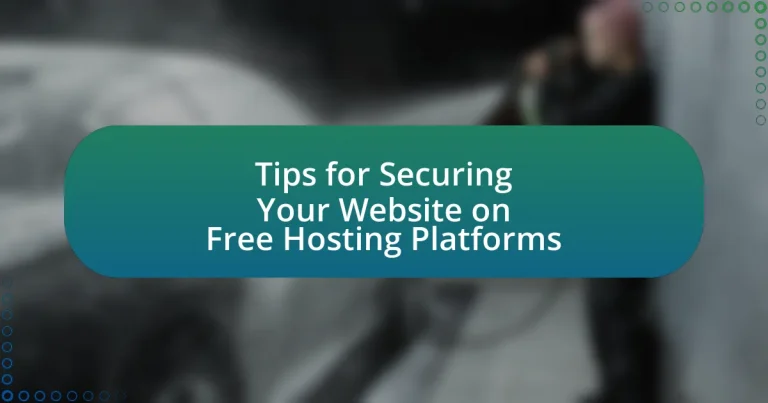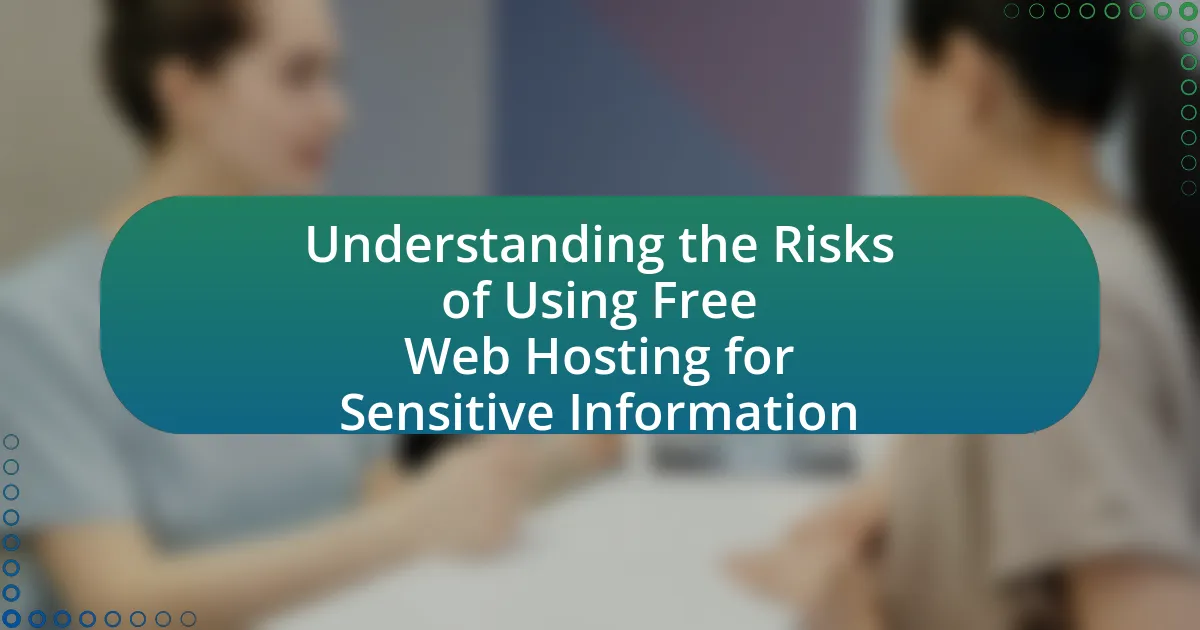The article focuses on essential tips for securing websites hosted on free platforms, highlighting the importance of implementing robust security measures due to the inherent vulnerabilities of these services. Key considerations include using HTTPS for data encryption, regularly updating software and plugins, employing strong passwords, and utilizing security plugins to enhance protection against malware and attacks. The article also addresses common security risks, the impact of breaches on websites and users, and best practices for ongoing security maintenance, including regular backups and monitoring for vulnerabilities. Additionally, advanced techniques such as Web Application Firewalls (WAF) and SSL certificates are discussed to further bolster website security.

What are the key considerations for securing your website on free hosting platforms?
To secure your website on free hosting platforms, prioritize using HTTPS to encrypt data transmission, as it protects sensitive information from interception. Additionally, regularly update your website’s software and plugins to patch vulnerabilities, since outdated systems are prime targets for attacks. Implement strong, unique passwords for all accounts associated with the website to prevent unauthorized access, as weak passwords are easily compromised. Utilize security plugins or tools available on the platform to enhance protection against malware and attacks, given that free hosting often lacks robust built-in security features. Finally, regularly back up your website data to ensure recovery in case of a security breach, as this mitigates data loss risks.
Why is website security important on free hosting platforms?
Website security is crucial on free hosting platforms because these services often lack robust security measures, making websites more vulnerable to attacks. Free hosting platforms typically have limited resources for security updates and monitoring, which increases the risk of data breaches, malware infections, and unauthorized access. According to a study by the Ponemon Institute, 60% of small businesses that experience a cyber attack go out of business within six months, highlighting the severe consequences of inadequate security. Therefore, ensuring website security on free hosting platforms is essential to protect sensitive information and maintain user trust.
What are the common security risks associated with free hosting?
Common security risks associated with free hosting include limited security measures, lack of support, and potential for data breaches. Free hosting providers often do not implement robust security protocols, leaving websites vulnerable to attacks such as hacking and malware infections. Additionally, the absence of technical support can hinder timely responses to security incidents. A study by the Cybersecurity & Infrastructure Security Agency (CISA) highlights that free hosting services are frequently targeted due to their inadequate security infrastructure, increasing the likelihood of data breaches and loss of sensitive information.
How can security breaches impact your website and users?
Security breaches can severely compromise your website and users by exposing sensitive data, leading to financial loss and reputational damage. When a breach occurs, attackers can access personal information such as usernames, passwords, and credit card details, which can result in identity theft and fraud. According to a 2020 report by IBM, the average cost of a data breach is $3.86 million, highlighting the financial implications for businesses. Additionally, users may lose trust in the website, leading to decreased traffic and engagement. A study by the Ponemon Institute found that 75% of consumers would stop using a company after a data breach. Thus, security breaches not only threaten the integrity of the website but also jeopardize user safety and trust.
What basic security measures should you implement?
To secure your website on free hosting platforms, implement basic security measures such as using strong passwords, enabling two-factor authentication, regularly updating software, and utilizing HTTPS. Strong passwords reduce the risk of unauthorized access, as studies show that 81% of data breaches are linked to weak passwords. Two-factor authentication adds an extra layer of security, making it significantly harder for attackers to gain access even if passwords are compromised. Regular software updates patch vulnerabilities, which is crucial since 60% of breaches involve known vulnerabilities that could have been fixed. Finally, HTTPS encrypts data transmitted between the user and the website, protecting sensitive information from interception.
How can you create strong passwords for your website?
To create strong passwords for your website, use a combination of at least 12 characters, including uppercase letters, lowercase letters, numbers, and special symbols. This complexity significantly increases the difficulty for attackers to guess or crack the password. According to a study by the National Institute of Standards and Technology (NIST), longer and more complex passwords are exponentially harder to breach, with a 12-character password being much more secure than shorter alternatives. Additionally, avoid using easily guessable information such as birthdays or common words, as these can be quickly compromised through social engineering tactics. Implementing a password manager can also help generate and store complex passwords securely, further enhancing your website’s security.
What role does two-factor authentication play in website security?
Two-factor authentication (2FA) significantly enhances website security by requiring users to provide two forms of verification before accessing their accounts. This additional layer of security mitigates the risk of unauthorized access, as even if a password is compromised, the second factor—such as a text message code or authentication app—remains secure. According to a study by Google, implementing 2FA can block 99.9% of automated attacks, demonstrating its effectiveness in protecting sensitive information on websites.
How can you protect your website from common threats?
To protect your website from common threats, implement strong security measures such as using HTTPS, regularly updating software, and employing firewalls. HTTPS encrypts data between the user and the server, reducing the risk of data interception. Regular software updates patch vulnerabilities that could be exploited by attackers, as evidenced by the fact that 60% of breaches involve unpatched software. Firewalls act as a barrier between your website and potential threats, filtering out malicious traffic. Additionally, using strong, unique passwords and enabling two-factor authentication can significantly enhance security by making unauthorized access more difficult.
What are the best practices for preventing malware attacks?
The best practices for preventing malware attacks include regularly updating software, using strong passwords, and implementing security plugins. Regular software updates patch vulnerabilities that malware can exploit, as evidenced by a report from the Cybersecurity & Infrastructure Security Agency, which states that 60% of breaches involve unpatched software. Strong passwords reduce the risk of unauthorized access; the National Institute of Standards and Technology recommends using complex passwords that are at least 12 characters long. Additionally, security plugins can provide real-time protection and malware scanning, significantly lowering the risk of infection.
How can you secure your website against DDoS attacks?
To secure your website against DDoS attacks, implement a combination of traffic filtering, rate limiting, and using a Content Delivery Network (CDN). Traffic filtering allows you to identify and block malicious traffic before it reaches your server, while rate limiting restricts the number of requests a user can make in a given timeframe, reducing the impact of an attack. Utilizing a CDN can distribute traffic across multiple servers, absorbing excess load during an attack. According to a report by Cloudflare, websites using CDNs experienced a 50% reduction in downtime during DDoS attacks, demonstrating the effectiveness of these strategies.
What advanced security techniques can enhance your website’s safety?
Advanced security techniques that can enhance your website’s safety include implementing Web Application Firewalls (WAF), utilizing Content Security Policy (CSP), and employing regular security audits. Web Application Firewalls protect against common threats such as SQL injection and cross-site scripting by filtering and monitoring HTTP traffic between a web application and the internet. Content Security Policy helps mitigate risks by specifying which dynamic resources are allowed to load, reducing the chances of malicious content being executed. Regular security audits identify vulnerabilities and ensure compliance with security standards, thereby maintaining a robust security posture. According to a report by the Ponemon Institute, organizations that conduct regular security audits can reduce the risk of data breaches by up to 50%.
How can SSL certificates improve your website security?
SSL certificates improve website security by encrypting data transmitted between the user’s browser and the web server. This encryption protects sensitive information, such as login credentials and payment details, from interception by malicious actors. According to a study by Google, websites using HTTPS (enabled by SSL certificates) are less likely to be targeted by cyberattacks, as the encryption adds a layer of security that deters potential threats. Additionally, SSL certificates help establish trust with users, as browsers display visual indicators, such as a padlock icon, signaling that the connection is secure. This trust can lead to increased user engagement and lower bounce rates, further enhancing overall website security.
What are the steps to obtain and install an SSL certificate?
To obtain and install an SSL certificate, follow these steps: First, choose a Certificate Authority (CA) that suits your needs, such as Let’s Encrypt for free certificates or a paid provider like DigiCert. Next, generate a Certificate Signing Request (CSR) on your server, which includes your public key and domain information. After that, submit the CSR to the chosen CA, which will validate your identity and issue the SSL certificate. Once you receive the certificate, install it on your web server by configuring the server settings to include the certificate files. Finally, test the installation using online tools like SSL Labs to ensure proper configuration and security. These steps are essential for securing data transmission on your website.
How does SSL encryption protect user data?
SSL encryption protects user data by establishing a secure, encrypted connection between a user’s browser and a web server. This encryption ensures that any data transmitted, such as personal information or payment details, is scrambled and unreadable to unauthorized parties during transit. SSL uses protocols like TLS (Transport Layer Security) to create this secure channel, which is essential for safeguarding sensitive information from eavesdropping and tampering. According to a study by Google, websites using SSL encryption see a significant reduction in data breaches, highlighting its effectiveness in protecting user data.
What are the benefits of using a web application firewall (WAF)?
A web application firewall (WAF) provides several key benefits, including enhanced security against common web threats, improved compliance with regulations, and increased application availability. WAFs protect web applications by filtering and monitoring HTTP traffic between a web application and the Internet, effectively blocking attacks such as SQL injection, cross-site scripting (XSS), and other vulnerabilities. According to a report by the Ponemon Institute, organizations that implement WAFs can reduce the risk of data breaches by up to 50%, demonstrating their effectiveness in safeguarding sensitive information. Additionally, WAFs can help businesses meet compliance requirements for standards like PCI DSS, which mandates security measures for online transactions. By mitigating risks and ensuring compliance, WAFs contribute to the overall reliability and trustworthiness of web applications hosted on free platforms.
How does a WAF filter and monitor HTTP traffic?
A Web Application Firewall (WAF) filters and monitors HTTP traffic by analyzing incoming requests and outgoing responses to identify and block malicious activities. The WAF employs predefined security rules and machine learning algorithms to detect threats such as SQL injection, cross-site scripting, and other web application vulnerabilities. By inspecting the payload of HTTP requests, the WAF can differentiate between legitimate traffic and potential attacks, thereby preventing harmful data from reaching the web application. This capability is supported by the fact that WAFs can log and report on traffic patterns, enabling ongoing monitoring and adjustment of security measures to adapt to evolving threats.
What features should you look for in a WAF for free hosting?
When selecting a Web Application Firewall (WAF) for free hosting, prioritize features such as real-time threat detection, customizable security rules, and automated updates. Real-time threat detection is crucial as it allows for immediate identification and mitigation of attacks, enhancing the security posture of your website. Customizable security rules enable you to tailor the WAF to your specific application needs, ensuring that legitimate traffic is not blocked while malicious requests are filtered out. Automated updates are essential to keep the WAF current with the latest security threats and vulnerabilities, as free hosting environments may not provide regular maintenance. These features collectively ensure robust protection against common web threats, such as SQL injection and cross-site scripting, which are prevalent in free hosting scenarios.

What ongoing practices should you adopt for maintaining website security?
To maintain website security, regularly update software, including content management systems, plugins, and themes. Keeping software up to date addresses vulnerabilities that could be exploited by attackers; for instance, a study by the Cybersecurity & Infrastructure Security Agency found that 60% of breaches involved unpatched vulnerabilities. Additionally, implement strong password policies and enable two-factor authentication to enhance access security. Regularly back up website data to recover from potential breaches or data loss, and conduct routine security audits to identify and mitigate risks. Monitoring website traffic for unusual activity can also help detect potential threats early.
How often should you update your website and its components?
You should update your website and its components at least once every month. Regular updates are essential for maintaining security, as outdated software can be vulnerable to attacks; for instance, a report by the Cybersecurity & Infrastructure Security Agency (CISA) indicates that 60% of data breaches are linked to unpatched vulnerabilities. Additionally, updating content regularly improves search engine rankings and user engagement, as search engines favor fresh content. Therefore, a monthly update schedule is a practical approach to ensure both security and relevance.
What are the risks of using outdated software and plugins?
Using outdated software and plugins significantly increases the risk of security vulnerabilities, making systems more susceptible to cyberattacks. Cybercriminals often exploit known vulnerabilities in outdated software; for instance, a report from the Cybersecurity and Infrastructure Security Agency (CISA) indicated that 60% of breaches involved unpatched vulnerabilities. Additionally, outdated software may lack essential updates that improve functionality and security, leading to potential data breaches and loss of sensitive information. Therefore, maintaining updated software and plugins is crucial for safeguarding websites against these risks.
How can regular backups contribute to your website’s security?
Regular backups enhance website security by ensuring that data can be restored in the event of a cyber attack, data corruption, or accidental deletion. When a website is compromised, having recent backups allows for a quick recovery, minimizing downtime and data loss. According to a study by the Cybersecurity & Infrastructure Security Agency, 60% of small businesses that experience a cyber attack go out of business within six months, highlighting the critical role of backups in maintaining operational continuity. Regularly scheduled backups also help in identifying vulnerabilities, as they provide a historical record of the website’s state, enabling administrators to detect unauthorized changes or malware infections.
What resources are available for monitoring your website’s security?
To monitor your website’s security, several resources are available, including security plugins, website monitoring services, and vulnerability scanners. Security plugins like Wordfence and Sucuri provide real-time monitoring, malware scanning, and firewall protection specifically for WordPress sites. Website monitoring services such as UptimeRobot and Site24x7 track website uptime and alert you to any downtime or security breaches. Vulnerability scanners like Qualys and Nessus assess your website for security weaknesses and provide detailed reports on potential vulnerabilities. These resources are widely used and recognized in the industry for their effectiveness in enhancing website security.
How can security plugins help in monitoring vulnerabilities?
Security plugins help in monitoring vulnerabilities by continuously scanning websites for known security issues and weaknesses. These plugins utilize databases of vulnerabilities to identify outdated software, insecure configurations, and potential entry points for attackers. For instance, plugins like Wordfence and Sucuri provide real-time monitoring and alerts, enabling website owners to address vulnerabilities promptly. Studies show that websites using security plugins experience a significant reduction in successful attacks, highlighting their effectiveness in maintaining website security.
What are the best tools for scanning your website for threats?
The best tools for scanning your website for threats include Sucuri SiteCheck, Qualys SSL Labs, and Wordfence. Sucuri SiteCheck offers a free malware scanner that checks for known malware, blacklisting status, and website errors. Qualys SSL Labs provides a comprehensive analysis of SSL/TLS configurations, ensuring secure data transmission. Wordfence is a popular WordPress security plugin that includes a firewall and malware scanner, actively protecting websites from threats. These tools are widely recognized for their effectiveness in identifying vulnerabilities and ensuring website security.
What are the common troubleshooting steps for security issues?
Common troubleshooting steps for security issues include identifying the source of the problem, assessing the extent of the breach, and implementing immediate fixes. First, check logs and alerts to pinpoint unauthorized access or anomalies. Next, evaluate the impact by determining what data or systems were affected. After assessing the situation, apply patches or updates to vulnerable software and change compromised passwords. Additionally, conduct a thorough security audit to identify any remaining vulnerabilities. These steps are essential as they help mitigate risks and prevent future incidents, ensuring the integrity of the website on free hosting platforms.
How can you identify if your website has been compromised?
You can identify if your website has been compromised by checking for unusual activity, such as unexpected changes to content, unauthorized access to admin accounts, or a sudden drop in traffic. Additionally, monitor for unfamiliar files or scripts in your website’s directory, as well as alerts from security plugins or services indicating potential breaches. According to a 2021 report by the Cybersecurity & Infrastructure Security Agency, 60% of compromised websites exhibit signs of defacement or malware injection, reinforcing the importance of vigilance in monitoring website integrity.
What immediate actions should you take if a security breach occurs?
Immediately isolate the affected systems to prevent further unauthorized access. This involves disconnecting the compromised server or network from the internet and other connected devices. Following isolation, assess the extent of the breach by reviewing logs and identifying compromised accounts or data. Notify relevant stakeholders, including your hosting provider and affected users, to inform them of the breach and any potential risks. Finally, begin remediation efforts, which include changing passwords, applying security patches, and restoring systems from secure backups. These actions are critical as they help contain the breach, minimize damage, and protect sensitive information.




